Citroen Dispatch Review 2025
Citroen Dispatch At A Glance
Developed as part of a joint venture between Citroen, Peugeot and Toyota, the new Dispatch provides significant improvements over the outgoing model, with higher carrying capacities, lower running costs and improved refinement.
The Dispatch will carry a maximum payload of 1400kg and will easily move up to three Euro pallets in one go. The new van is also capable of towing 2.5 tonnes when hooked up to a braked trailer, which is 500kg more than the old van. It’s available in van, crew van and chassis cab bodystyles.
Engines range from 1.6-litre to 2.0-litre BlueHDi diesels, with power outputs ranging from 95PS to 180PS, with automatic transmission optional on the entry-level motor and mandatory on the highest power output. All will return more than 50mpg on paper, with Citroen claiming 55.4mpg for the best-performing 1.6 BlueHDi 115. This gives the Dispatch a significant on-paper running cost advantage over rivals from Volkswagen, Ford, Renault, Vauxhall and Mercedes-Benz.
Three body lengths are available - M, XL and XS. In its smallest wheelbase, the Dispatch will carry lengths of 3.3m, but this increases to 4.0m in the XS versions. The interior has a clean look, with all models providing a central seven-inch touchscreen as standard. It also has a ‘mirror screen’ function, compatible with Mirror Link and Apple CarPlay technology, allowing certain smartphone apps to be accessed and controlled from the van’s dashboard screen.
The Dispatch gets a number of new features over the old model, with hands-free sliding doors that can be accessed with a simple foot motion. The loadspace bulkhead also gets a handy flap at the base, allowing you to utilise the vehicle's full length by sliding pipes, planks of wood or a ladder under the front passenger's seat.
The cabin gets more car-like features, with an optional seven-inch TomTom touchscreen displaying navigation and traffic alerts. All Experts get two seats as standard, while higher spec models get the option of three. Crew cab versions to carry up to six.
Cheap to run, comfortable and extremely practical, the Dispatch improves on its predecessor on every level. Admittedly, some might criticise the lack of high-roof option, but Citroen's medium-sized van remains one of the best in its segment for day-to-day usability and costs.
Essential knowledge: 10 things you need to know about the Citroen Dispatch
Driving the Citroen Dispatch
Citroen offers a choice of five power outputs with the Dispatch, from two different engines: a 1.6 Blue HDi and a 2.0 BlueHDi, both of which require AdBlue to help cut exhaust emissions.
The engine line-up starts with a 95PS 1.6 BlueHDi producing 210Nm of torque at 1500rpm. It has a five-speed manual gearbox and will reach 62mph from rest in 15.5 seconds. The automatic option on this is an a torque converter auto. The manual has CO2 emissions from 144g/km and fuel claimed economy of 51.4mpg.
The 115PS version of the 1.6 BlueHDi packs more power, with 300Nm of torque at 1750rpm. It comes with stop/start technology as standard and will return an official 55.4mpg. The version we drove was carrying a 300kg load, and provided smooth progress with ample acceleration and car-like steering responses. It also offers a great balance of performance and running costs.
Citroen also offers a 120PS Dispatch with the 2.0-litre BlueHDi engine, and while it might seem odd to offer similar power outputs from two different engines, the larger one has substantially more torque at 340Nm as well as a much higher maximum towing limit. It will pull up to 2500kg (braked) compared with 1800-2000kg for the 1.6 BlueHDi, depending on specification. The 120PS version is offered with a manual or EAT8 automatic transmission.
The 150PS 2.0 BlueHDi feels a lot more responsive than the 1.6, and might have more appeal for an owner-driver with a slightly more relaxed gait at higher speeds, while the range topping 180PS 2.0 BlueHDi will only interest those who regularly need to utilise the Dispatch's 2.5 tonne towing capacity and 1.5 tonne payload. The 180PS is linked to a torque converter automatic shift gearbox as standard.
The Dispatch is also available with a head-up display for the first time – a sector first. A transparent screen in the driver’s eye-line can show essential driving information (actual and recommended speed, cruise control/speed limiter setting, navigation instructions, and collision risk alerts).
Speed limits are read from road signs, so there is no way to remind drivers of lower LCV speed limits. Other options include an automatic dipping main beam, a 180 degree rear camera function and some are available with Citroen’s Grip Control, which improves traction on slippery surfaces.
Citroen Dispatch interior
The Dispatch looks and feels like a more capable van than its predecessors. The seating position is higher than before, giving the driver an improved view of the road ahead, and it also helps with the packaging of the load area. But despite the higher driving position, the van’s height at 1.9m means it can still fit in a multi-storey car park.
The side doors can be specified as hands-free, allowing them to be opened when a proximity sensor at the rear is activated by movement of the foot under the corner of the rear bumper. The vehicle unlocks and the sliding side door on the relevant side opens automatically.
The Dispatch has a load volume ranging from 5.1 cubic metres to 6.6 cubic metres, depending on specification. The front passenger seat has a modular design, and a special bulkhead and a flat floor extends the maximum load length of the New Dispatch by an extra 1.16m on the passenger side.
Payloads range from just under 1100kg to just over 1400kg depending on size, number of seats and engine. It’s available in van, crew van and chassis cab variants.
To cater for those who use their vans as a mobile office the central arm rest lowers to provide a pivoting table with an elastic and adhesive strip to keep objects in place (such as PCs or tablets). In addition, special holders for smartphones and tablets are available as accessories.
The front of the cab is home to a lower glove box with a jack, 12V socket and USB socket. The storage space under the passenger seat is large enough for a pair of shoes or a hard-hat. Cup holders are specified on both sides of the dashboard. A central upper storage area and two door bins large enough for 1.5-litre bottles of water also add to the mobile office credentials of the dispatch.
Model History
- April 0219: Dispatch gets Euro6.2 engines
- April 2016: New Citroen Dispatch launched
- April 2016: Pricing for Citroen Dispatch confirmed
- October 2019: BlueHDi 120 S&S EAT8 automatic added to Dispatch
April 0219
Dispatch gets Euro6.2 engines
Citroen has announced the 2019 Dispatch range which will introduce new specification, new WLTP-compliant Euro6.2 engines and revised options
Euro 6.2 engines that comply with the latest WLTP emissions and fuel consumption test requirements, revised options and a revised model range signal the launch of the 2019 Citroën Dispatch, due to begin production in May.
The Dispatch also gets “Worker” and “Driver” trim levels. The changes, available in Panel Van and Crew Van versions help to simplify the engine range and trim options, while ensuring that Dispatch complies with the latest EU emissions and fuel consumption testing well ahead of the implementation date in September 2019.
Dispatch Worker equipment includes the Moduwork bulkhead with Load-through flap, dual passenger bench seat with fold-up outer seat and fold-down writing table, ground clearance raised by 20mm, accompanied by a 20mm thick sump guard and enhanced traction modes enabled by introducing Grip Control as standard. Dispatch Worker models offer payloads of up to 1400kgs and equipped with 17-inch steel wheels with all season Mud and Snow tyres, improving traction on un-surfaced roads and in poor weather.
Dispatch “Driver” has been designed for van users who spend a lot of time on the road and would therefore benefit from Citroën’s Advanced Comfort Programme. Dispatch Driver equipment includes enhanced acoustic and thermal materials designed to improve refinement and offer outstanding comfort, while a range of additional safety and driver assistance options are included as standard equipment. This includes the Safety Pack that incorporates a Lane Departure Warning System, Speed Limit Recognition, Intelligent Speed Adaptation, Driver Attention Alert and smart beam headlights. Driver Assist Pack is also included, bringing Adaptive Cruise Control, Collision Alert and Active Safety Brake.
Other standard equipment for Dispatch Driver includes a 7-inch colour touchscreen, providing Citroën Connect Navigation with DAB radio and voice recognition, in addition to the Park Assist 180° pack that includes front and rear parking sensors with blind spot monitoring and 180° rear view camera.
April 2016
New Citroen Dispatch launched
Born out of a collaboration between Citroen, Peugeot and Toyota, the new Dispatch is powered by a new range of 1.6 and 2.0-litre diesel engines returning up to 55mpg. Most engines are linked to a six-speed manual gearbox as standard, but the powerful 2.0-litre with 180PS will be aligned with a six-speed automatic and return a claimed 46.3mpg. All will use AdBlue, which will cover roughly 9000 miles before it need replenishing via the exterior filling flap.
Available in three load lengths, the Dispatch will carry 1400kg and tow a maximum 2.5 tonnes when hooked up to a braked trailer. The maximum load length for compact versions will be 3.3 metres, but this will increase to more than 4.0 metres with the long wheelbase versions.
All vans will carry three Euro pallets with ease and feature smart storage options, with a large hatch built into the bulkhead to maximise the full load length of the van.
April 2016
Pricing for Citroen Dispatch confirmed
The New Dispatch will be offered with a choice of three, well-equipped trim levels: X, Enterprise and Enterprise Plus.
The 47 model Citroen Dispatch LCV range is as follows:
| New Citroën Dispatch X | MRB Price* |
| New Dispatch Panel Van BlueHDi 95 manual XS 1000 X | £17,495 |
| New Dispatch Panel Van BlueHDi 95 S&S ETG6 XS 1000 X | £18,275 |
| New Dispatch Panel Van BlueHDi 115 S&S 6-speed manual XS 1000 X | £18,295 |
| New Dispatch Panel Van BlueHDi 120 S&S 6-speed manual XS 1400 X | £18,695 |
| New Dispatch Panel Van BlueHDi 150 S&S 6-speed manual XS 1400 X | £19,795 |
| New Dispatch Panel Van BlueHDi 180 S&S EAT6 XS 1300 X | £22,795 |
| New Dispatch Panel Van BlueHDi 95 manual M 1000 X | £18,195 |
| New Dispatch Panel Van BlueHDi 95 S&S ETG6 M 1000 X | £18,975 |
| New Dispatch Panel Van BlueHDi 115 S&S 6-speed manual M 1000 X | £18,995 |
| New Dispatch Panel Van BlueHDi 120 S&S 6-speed manual M 1400 X | £19,395 |
| New Dispatch Panel Van BlueHDi 150 S&S 6-speed manual M 1400 X | £20,495 |
| New Dispatch Panel Van BlueHDi 180 S&S EAT6 M 1250 X | £23,495 |
| New Dispatch Panel Van BlueHDi 95 manual XL 1200 X | £19,095 |
| New Dispatch Panel Van BlueHDi 95 S&S ETG6 XL 1200 X | £19,875 |
| New Dispatch Panel Van BlueHDi 120 S&S 6-speed manual XL 1400 X | £20,295 |
| New Dispatch Panel Van BlueHDi 150 S&S 6-speed manual XL 1400 X | £21,395 |
| New Dispatch Panel Van BlueHDi 180 S&S EAT6 XL 1250 X | £24,395 |
| New Citroën Dispatch Enterprise | |
| New Dispatch Panel Van BlueHDi 95 manual XS 1000 Enterprise | £18,845 |
| New Dispatch Panel Van BlueHDi 95 S&S ETG6 XS 1000 Enterprise | £19,625 |
| New Dispatch Panel Van BlueHDi 115 S&S 6-speed manual XS 1000 Enterprise | £19,645 |
| New Dispatch Panel Van BlueHDi 120 S&S 6-speed manual XS 1400 Enterprise | £20,045 |
| New Dispatch Panel Van BlueHDi 150 S&S 6-speed manual XS 1400 Enterprise | £21,145 |
| New Dispatch Panel Van BlueHDi 180 S&S EAT6 XS 1300 Enterprise | £23,545 |
| New Dispatch Panel Van BlueHDi 95 manual M 1000 Enterprise | £19,545 |
| New Dispatch Panel Van BlueHDi 95 S&S ETG6 M 1000 Enterprise | £20,325 |
| New Dispatch Panel Van BlueHDi 115 S&S 6-speed manual M 1000 Enterprise | £20,345 |
| New Dispatch Panel Van BlueHDi 120 S&S 6-speed manual M 1400 Enterprise | £20,745 |
| New Dispatch Panel Van BlueHDi 150 S&S 6-speed manual M 1400 Enterprise | £21,845 |
| New Dispatch Panel Van BlueHDi 180 S&S EAT6 M 1250 Enterprise | £24,245 |
| New Dispatch Panel Van BlueHDi 95 manual XL 1200 Enterprise | £20,445 |
| New Dispatch Panel Van BlueHDi 95 S&S ETG6 XL 1200 Enterprise | £21,225 |
| New Dispatch Panel Van BlueHDi 120 S&S 6-speed manual XL 1400 Enterprise | £21,645 |
| New Dispatch Panel Van BlueHDi 150 S&S 6-speed manual XL 1400 Enterprise | £22,745 |
| New Dispatch Panel Van BlueHDi 180 S&S EAT6 XL 1250 Enterprise | £25,145 |
| New Citroën Dispatch Enterprise Plus | |
| New Dispatch Panel Van BlueHDi 120 S&S 6-speed manual XS 1400 Enterprise Plus | £21,645 |
| New Dispatch Panel Van BlueHDi 150 S&S 6-speed manual XS 1400 Enterprise Plus | £22,745 |
| New Dispatch Panel Van BlueHDi 180 S&S EAT6 XS 1300 Enterprise Plus | £25,145 |
| New Dispatch Panel Van BlueHDi 120 S&S 6-speed manual XS 1400 Enterprise Plus | £22,345 |
| New Dispatch Panel Van BlueHDi 150 S&S 6-speed manual M 1400 Enterprise Plus | £23,445 |
| New Dispatch Panel Van BlueHDi 180 S&S EAT6 M 1250 Enterprise Plus | £25,845 |
| New Dispatch Panel Van BlueHDi 120 S&S 6-speed manual XL 1400 Enterprise Plus | £23,045 |
| New Dispatch Panel Van BlueHDi 150 S&S 6-speed manual XL 1400 Enterprise Plus | £24,145 |
| New Dispatch Panel Van BlueHDi 180 S&S EAT6 XL 1250 Enterprise Plus | £26,545 |
| New Citroën Dispatch Chassis Cabs | |
| New Dispatch Platform Cab BlueHDi 95 manual 1200 X | £17,425 |
| New Dispatch Platform Cab BlueHDi 120 S&S 6-speed manual 1400 X | £18,625 |
| New Citroën Dispatch Crew Vans | |
| New Dispatch Crew Van BlueHDi 120 S&S 6-speed manual M 1400 Enterprise | £20,045 |
| New Dispatch Crew Van BlueHDi 120 S&S 6-speed manual XL 1400 Enterprise | £24,195 |
Key features of each of the three trim levels are listed below:
| DISPATCH X: | DISPATCH ENTERPRISE: | DISPATCH ENTERPRISE PLUS: | ||
| In addition to DISPATCH X | In addition to ENTERPRISE | |||
| Twin sliding side doors | Alarm | Upgraded payload | ||
| Unglazed twin rear doors | Rear parking sensors | Rear parking camera | ||
| Full steel bulkhead | Moduwork | Automatic illumination of headlights | ||
| Remote locking with deadlocks | Touchscreen DAB Audio Pack | Automatic windscreen wipers | ||
| Dual passenger bench seat | Air conditioning | Body colour bumpers | ||
| Driver & passenger airbags | Heated/electric door mirrors | Front fog lights | ||
| DAB Radio | 16-inch alloy wheels | |||
| Bluetooth® | Metallic paint | |||
| 12 volt socket in dashboard | ||||
| Speed limiter /cruise control | ||||
| Electric windows | ||||
| Full size steel spare wheel |
October 2019
BlueHDi 120 S&S EAT8 automatic added to Dispatch
The BlueHDi 120 S&S EAT8 auto drivetrain is available with the Enterprise trim in both Panel Van and Crew Van M (Medium length) models. Dispatch Enterprise trim provides comprehensive specification, including: air conditioning, rear parking sensors, 7-inch colour touchscreen with Citroën Connect DAB radio, Bluetooth, Apple Car Play, Android Auto, automatic lights and automatic windscreen wipers.

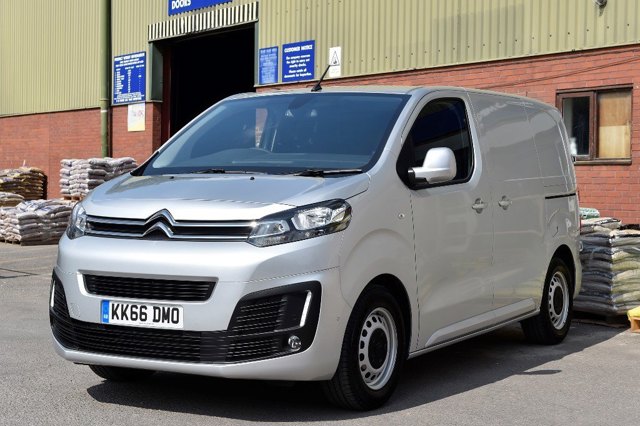
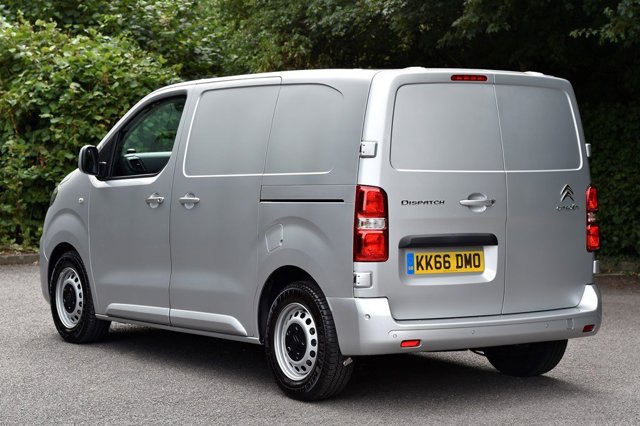
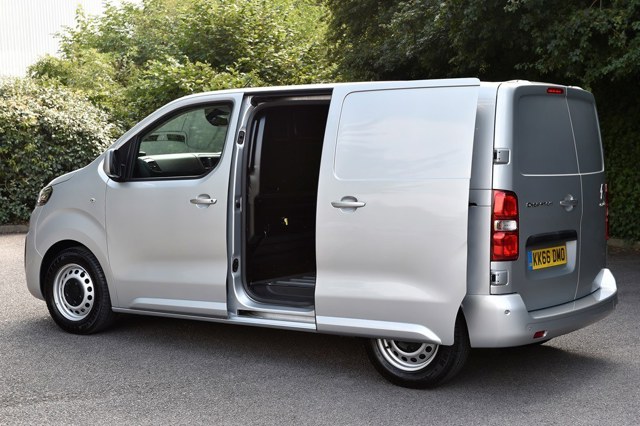

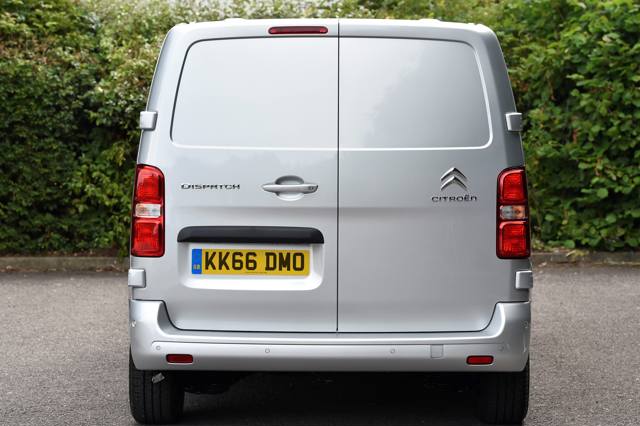
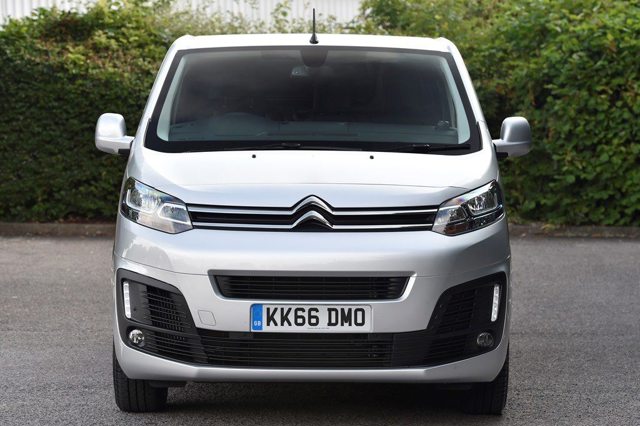
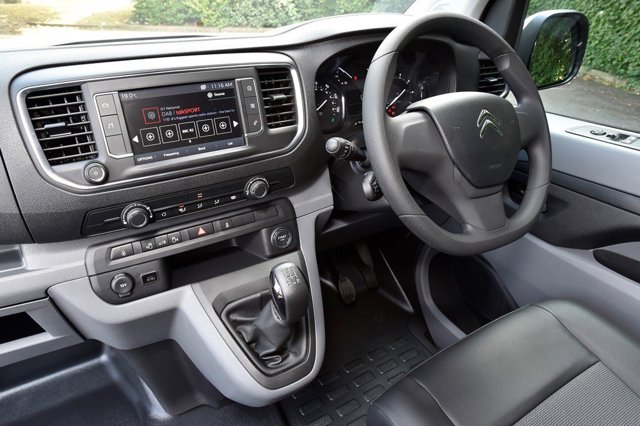
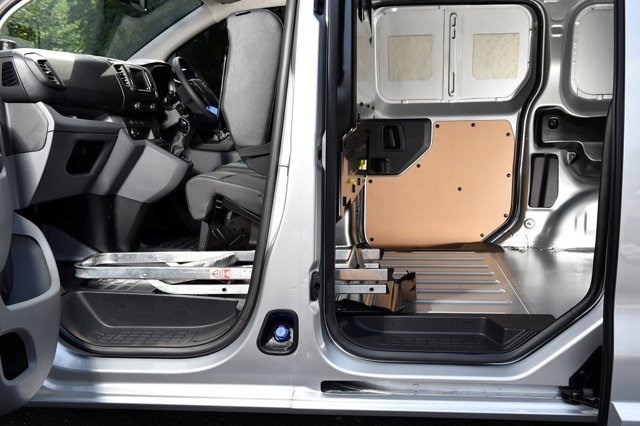


 Excellent official fuel economy figures, useful hi-tech features, smooth and refined drive.
Excellent official fuel economy figures, useful hi-tech features, smooth and refined drive.
 Automatic gearbox restricted to two engine variants, no high-roof option.
Automatic gearbox restricted to two engine variants, no high-roof option.


